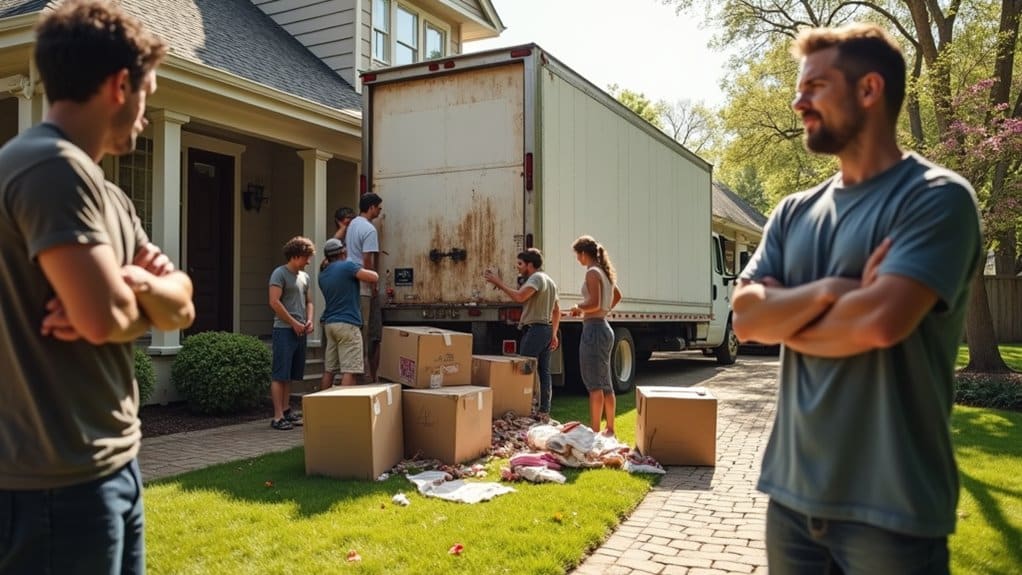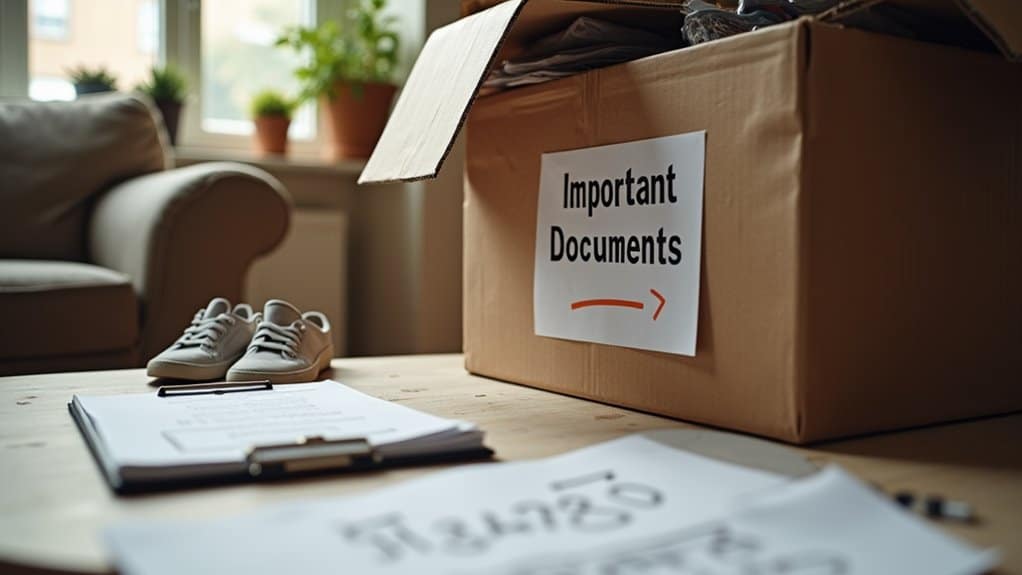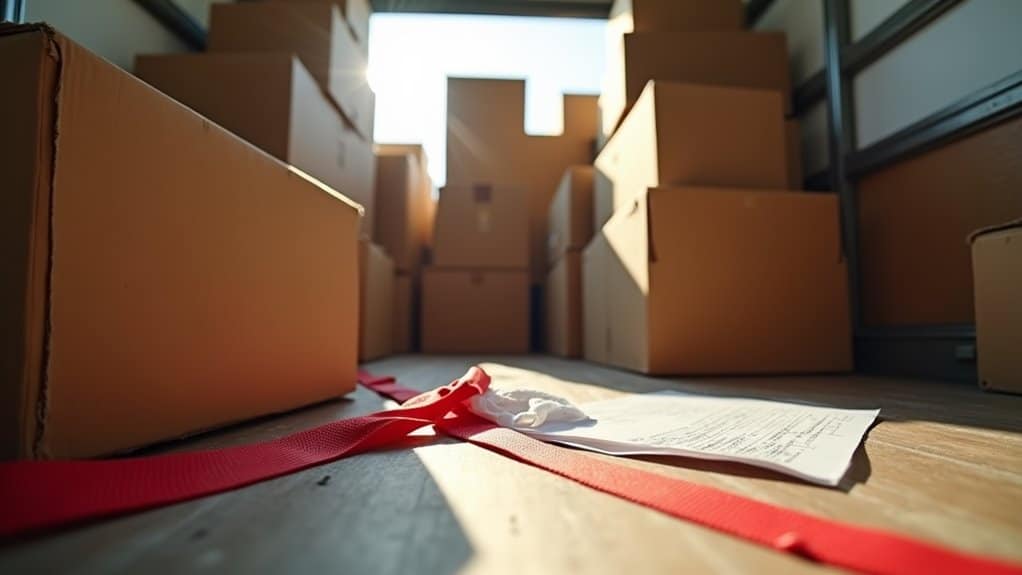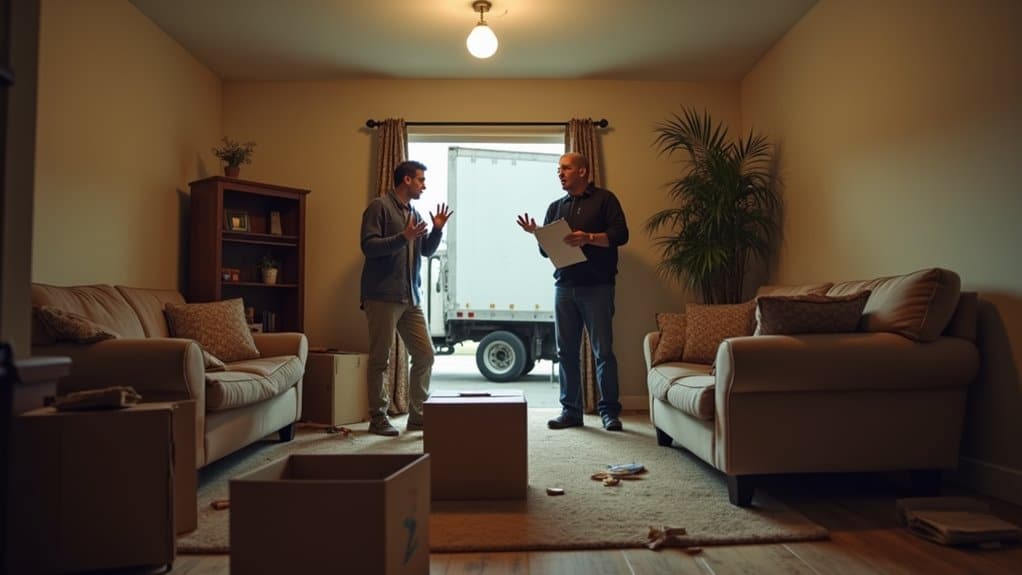
Common Mistakes to Avoid During Local House Removals
To avoid common mistakes during local house removals, start with careful planning. Make a checklist, declutter your belongings, and inform utility providers to prevent service interruptions. Use appropriate packing materials to safeguard your items, and select a trustworthy moving company by checking reviews and confirming credentials. Ensure you have the necessary parking permits and a clear plan for moving day. Don't forget to update your address with important institutions, and take some time after the move to assess what could be improved for next time. Stay tuned for more tips to make your local move smoother and more efficient.
Key Takeaways
- Not decluttering before you pack can create unnecessary stress and bump up your moving costs. Consider sorting through your belongings and getting rid of items you no longer need.
- Failing to research and compare moving companies might lead you to choose unreliable or overpriced movers. Take the time to read reviews and get quotes from multiple firms.
- Forgetting to confirm moving dates and details with your movers can cause miscommunication and delays on the big day. Always double-check these details in advance.
- Skipping a moving checklist can mean important tasks are overlooked, leading to last-minute chaos. Create a list to keep track of everything that needs to be done.
- Neglecting to update your address with crucial services can disrupt mail delivery and important communications. Make sure to inform banks, utility providers, and other essential services of your new address.
Pre-Move Planning Errors
Before you start your house move, it's vital to avoid common pre-move planning mistakes that can cause unnecessary stress. One of the first things to do is create a moving checklist. This will help you keep track of tasks and deadlines, so you don't miss crucial details. Without it, you might find yourself rushing at the last minute.
Start researching reputable moving companies at least 4-6 weeks before your move. This gives you ample time to compare quotes and book your preferred date. Waiting to research movers can lead to scheduling conflicts and limited options, which can increase your stress levels. It's important to remember that trust is crucial when selecting a removals company to ensure the safety of your belongings.
Also, take time to declutter and organise your belongings. Getting rid of items you don't need can significantly lighten your packing load.
Remember to notify utility providers and other relevant parties well in advance. This simple step can help avoid service disruptions during your move.
Additionally, create a timeline with specific deadlines for each task, and be prepared for potential delays, as they can happen unexpectedly.
Lastly, think ahead about unpacking and settling into your new home. By addressing these pre-move planning issues, you'll pave the way for a smoother and more organised relocation.
Inefficient Packing Techniques
Once you've sorted your pre-move planning, it's time to concentrate on efficient packing techniques. Start by decluttering your belongings and categorising them into four groups: pack, donate, sell, and throw away. This simplifies packing and prevents damage to items you no longer need.
Use the right packing materials. Make sure you have a variety of boxes in different sizes for better organisation. Wrap fragile items carefully to protect them during transport, and remember to pack heavier items at the bottom of boxes, with lighter items on top to ensure stability. Hiring professional movers can enhance this process by providing necessary equipment for safe transport. Additionally, consider the average packing timelines for your home size to ensure you allocate enough time for each room.
Maximise space by rolling clothes and using soft items like towels as cushioning, which can also reduce your need for extra packing materials. Clearly label each box with its contents and the room it belongs to, making unpacking much easier.
Lastly, avoid packing randomly; focus on one room at a time to stay organised. By following these strategies, you'll make your move smoother and minimise the chances of damage or confusion.
Choosing the Wrong Movers

Choosing the wrong movers can turn your relocation into a stressful ordeal. To avoid this, it's vital to recognise the warning signs of an unreliable moving company. Here are three key red flags to look out for:
- Lack of transparency: If a company's website doesn't provide a physical address or details about their registration with the relevant authorities, be wary.
- Pushy sales tactics: If representatives are pressuring you for immediate deposits or giving estimates without an in-person inspection, it's time to reconsider.
- Inconsistent online presence: A company boasting years of experience but lacking consistent reviews should raise concerns.
Do your homework by checking credentials, reading reviews, and comparing multiple quotes. Planning several weeks in advance will also allow you to thoroughly vet potential movers.
Ensure you receive a detailed written estimate and inquire about subcontracting practices. A reputable mover will offer clear information about their services and policies.
Avoid rushing your decision, as the wrong choice can lead to delays, damaged items, and unexpected costs.
Prioritising quality over price will help you sidestep potential issues later. Remember, your move deserves a dependable team!
Logistical Oversights
When planning your move, don't ignore the logistical details that can significantly impact the process. Securing parking permits, measuring your furniture to ensure it fits through doorways, and considering the weather are all vital for a smooth transition. Additionally, creating a detailed checklist can help ensure that no important tasks are overlooked. Addressing these points ahead of time can save you time, money, and unnecessary stress on moving day. Moreover, hiring professional movers who adhere to uniform service policies can further enhance the efficiency of your move.
Parking Permits and Access
Arranging parking permits and access is crucial for a smooth house move. Ignoring these details can lead to stress and delays.
Here's what you need to keep in mind:
- Permit Application: In many UK towns and cities, you must apply for a moving permit at least two weeks in advance. Without it, you could face fines or disruptions on moving day.
- Parking Regulations: Each area has its own parking rules, so it's essential to familiarise yourself with the regulations in your new neighbourhood. Ignoring these can result in hefty fines or even your vehicle being towed. Additionally, be aware that alternate side parking rules may apply in certain areas, which can affect your moving schedule.
- Access Arrangements: Check parking options ahead of time, and consider hiring professional movers who are familiar with local requirements. They can handle the parking logistics, ensuring a hassle-free experience on the day of your move.
Furniture Measurements and Fit
Furniture measurements and fit are crucial when planning a house move, yet they're often overlooked, leading to logistical headaches. To avoid these issues, measure all doorways, hallways, and staircases. Ensure you account for the dimensions of your furniture alongside any skirting boards or moulding.
Don't forget to measure diagonally in tight spaces to guarantee a fit.
When measuring furniture, use a reliable tape measure and jot down your findings. For sofas, check the back height, seat depth, and total width. For tables, measure the tabletop dimensions and height from the floor. Beds require careful measuring too—consider the mattress size, frame, and overall height.
Always double-check your measurements; having someone else verify can help catch mistakes. Using painter's tape to outline the dimensions of larger items on the floor can provide a clearer sense of fit.
If certain pieces seem tricky, consider taking them apart for easier transport. Lastly, measure the new space before the move to ensure everything will fit as expected.
Weather Preparedness and Planning
Planning for weather-related challenges during a house move is crucial, as conditions can change swiftly. Being unprepared can lead to stress, damage, and delays.
To ensure a smooth transition, consider the following:
- Stay Informed: Keep an eye on severe weather alerts and local evacuation orders. A weather radio can be invaluable for real-time updates.
- Emergency Kits: Prepare kits with essentials like food, water, medications, and important documents. This ensures you're ready for any eventuality.
- Evacuation Routes: Have multiple evacuation routes planned and know where local shelters are located, particularly those that accommodate pets.
Change of Address Mistakes

Navigating the change of address process can be daunting, but steering clear of common mistakes is crucial for a hassle-free move. One major error is neglecting to inform the Royal Mail. Failing to do so can result in delayed or lost post, leading to unnecessary stress.
It's also essential to double-check your address details; any inaccuracies can cause mail to be misdirected.
Make sure to update all relevant parties, such as banks, utility providers, and government agencies. Overlooking these updates could disrupt services and even impact your voter registration and tax information. A comprehensive notification checklist can help you track everyone who needs to be informed.
Additionally, confirm you're selecting the right change of address option—whether for an individual or a family—as this affects mail forwarding.
It's wise to verify your new address with your landlord or estate agent to avoid any discrepancies.
Finally, keep records of the entire process. Confirming that your address change has been received ensures everything is processed correctly.
First-Night Essentials Neglected
As moving day approaches, it's easy to forget about packing first-night essentials, which can lead to unnecessary stress in your new home.
To ensure a smoother transition, prioritise these items early:
- Toiletries: Don't forget your toothbrush, toothpaste, shampoo, and other personal care items.
- Medications: Pack your prescription meds, pain relievers, and a basic first aid kit.
- Electronics: Make sure to include phone chargers and any necessary cables.
Keep these items in a separate, clearly labelled box so you can easily locate them amidst the chaos of moving day.
This simple step saves you time and meets your immediate needs without having to rummage through multiple boxes.
Load Security Issues

When preparing for a house move, it's crucial to secure your items properly to prevent damage.
Use appropriate equipment such as moving blankets and straps to keep everything in place during transport. This not only protects your belongings but also makes the moving process smoother and safer.
For instance, wrapping fragile items in blankets can help avoid breakages.
Properly Securing Items
Properly securing items during house removals is essential for safe and damage-free transport. Failing to secure your load can result in damage to your belongings and create safety hazards on the road.
To prevent these issues, consider these key securing techniques:
- Use a variety of securing methods: Combine ropes, straps, and belts to ensure your load is firmly held in place.
- Secure items to the vehicle's structure: Always attach your load to the vehicle's sturdy framework, avoiding soft surfaces that won't provide adequate support.
- Watch your load capacity: Make sure your van isn't overloaded, as excessive weight can put pressure on your items and cause damage.
Using Appropriate Equipment
Securing your items properly is crucial for a successful house move, and using the right equipment is key for load safety. Relying solely on friction isn't sufficient; always use load securing belts, straps, chains, or braces to ensure your belongings stay secure during transit.
Avoid makeshift solutions like curtains or weather protection, as they don't provide the necessary stability.
Ensure even weight distribution in your vehicle by placing heavier items at the bottom and lighter ones on top. This helps maintain balance and prevents shifting.
While over-strapping can be safer, avoid experimenting with new securing methods while driving, as this can pose risks.
Make sure your equipment is suitable for the type and weight of your load. Strong furniture moving pads or blankets can shield your items from damage, while ropes, hooks, and tensioners effectively secure them.
Using proper load securing equipment will minimise the risk of accidents and lead to a smoother moving experience.
Lack of Emergency Plans
In the chaos of moving house, having an emergency plan can make a significant difference. Unexpected situations can arise, so being prepared is crucial. Here are three key components to consider for effective emergency preparedness:
- Multiple Evacuation Routes: Knowing alternative routes ensures safety if your usual paths are blocked.
- Designated Meeting Points: Set locations for family members to regroup can reduce panic if you become separated.
- Communication Plans: Keep contact details updated and decide how to stay informed about local alerts.
Regularly practising these plans improves family communication and ensures everyone knows what to do in an emergency.
It's also wise to review your emergency strategies each year, adapting them to any changes in your circumstances. This proactive approach will help protect your belongings and provide peace of mind during your move.
By prioritising an emergency plan, you're setting your family up for a smoother, safer relocation.
Don't underestimate the importance of preparation—these steps can significantly reduce stress when it matters most.
Poor Communication With Movers

Poor communication with your movers can cause unnecessary stress and complications on moving day.
To ensure a smooth process, it's crucial to provide clear instructions and promptly notify them of any changes. For example, if you decide to change the moving date or add items to the list, let them know as soon as possible.
Good communication helps prevent misunderstandings and paves the way for a successful move.
Clear Instructions for Movers
To ensure a smooth moving experience, clear communication with your movers is vital. Providing concise and detailed instructions helps reduce the risk of mistakes.
Here are three essential steps to take:
- Create a detailed checklist of tasks that need to be completed. Include specific timelines to keep everyone informed.
- Discuss any special handling needed for fragile or valuable items. Make sure your movers know what requires extra care to prevent damage.
- Confirm the moving schedule and deadlines with your movers. Ensuring everyone understands the timelines keeps things on track.
It's also important to request written confirmation of all agreed details. This reinforces clarity and gives you a reference if issues arise.
Engaging in pre-move planning and being present on moving day allows you to guide the process effectively. Clear communication and thorough instructions will set the foundation for a hassle-free move.
Timely Updates and Changes
Effective communication is crucial for a successful move, but timely updates about any changes are equally important. If you need to adjust your moving schedule, let your movers know as soon as possible to avoid complications. Last-minute changes can lead to service interruptions or missed appointments, which may increase your costs.
Using clear notification methods, such as emails or text messages, ensures your movers receive updates in writing. Always confirm changes to prevent misunderstandings. Delaying your notification can result in incorrect services or even damage to your belongings.
It's also vital to keep key stakeholders, like utility companies, banks, and insurance providers, informed. This helps maintain service continuity and prevents interruptions.
To make this process easier, create a moving checklist to track all updates and changes. Regularly reviewing your plans ensures accuracy and keeps you organised.
Establishing a clear communication channel with your movers and other relevant parties can significantly improve your moving experience, making it smoother and less stressful.
Post-Move Review Failures
Many people underestimate the value of a post-move review, which can result in missed chances for improvement in future relocations. Reflecting on your experience can significantly enhance your next move. Here are three common mistakes to steer clear of:
- Unpacking Haphazardly: This can create chaos and frustration when you're trying to find essential items.
- Skipping the Post-Move Review: Without this step, you may not recognise what went well or what didn't, losing out on valuable insights for future moves.
- Not Recording Damage: Failing to document any damage can complicate your ability to seek compensation if necessary.
A detailed post-move review allows you to identify inefficiencies, whether it's forgetting to update your address or overlooking inventory lists.
Reflecting on every aspect of your move is crucial for smoother future relocations. By acknowledging these pitfalls, you can adopt better strategies for next time.
Don't let post-move chaos dictate your next experience; take the time to review and improve.
Frequently Asked Questions
How Do I Choose the Best Time for My Move?
To choose the best time for your move, steer clear of peak moving seasons and weekends, as prices tend to be higher. Opt for midweek days for greater flexibility and reduced costs. Planning ahead will help ensure a smoother transition. For example, moving on a Tuesday or Wednesday can often save you money and make the process less stressful.
What Items Are Prohibited From Being Moved?
Moving can feel like navigating a minefield; it's crucial to steer clear of prohibited items. Avoid packing hazardous materials like chemicals or flammable items, as well as perishable goods such as fresh food. It's also wise to leave behind sentimental belongings that might get damaged. Protect your move by knowing what you can't take with you.
Can I Move During Bad Weather?
You can move during bad weather, but it's essential to take the right precautions. Assess the weather conditions carefully; if they worsen, it may be wise to postpone your move. Protect your belongings—use waterproof covers for furniture and secure boxes properly. Always prioritise safety to ensure a smooth moving experience.
How Do I Handle Valuable or Fragile Items?
To handle valuable or fragile items, use reliable packing methods such as bubble wrap and strong boxes. It's wise to explore insurance options for extra protection. Clearly label all items to ensure they are handled with care during your move. For example, if you're transporting a fine china set, wrap each piece individually and mark the box as 'fragile' to alert movers.
What Should I Do if I Need to Reschedule My Move?
If you need to reschedule your move, such as in the event of a family emergency, it's essential to inform your movers as soon as possible. Refer to your moving checklist and follow these rescheduling tips to ensure a seamless transition and to avoid any additional charges.
Conclusion
Moving house locally can be both exciting and stressful. With proper planning, you can make your move smooth, but missing key details can lead to chaos. You want your new chapter to start off right, not hindered by last-minute troubles. To ensure a successful move, steer clear of common mistakes such as poor communication and ineffective packing. For instance, label your boxes clearly to avoid confusion on moving day. Remember, a little preparation goes a long way in turning a potentially stressful experience into a hassle-free transition.


